|
The Film
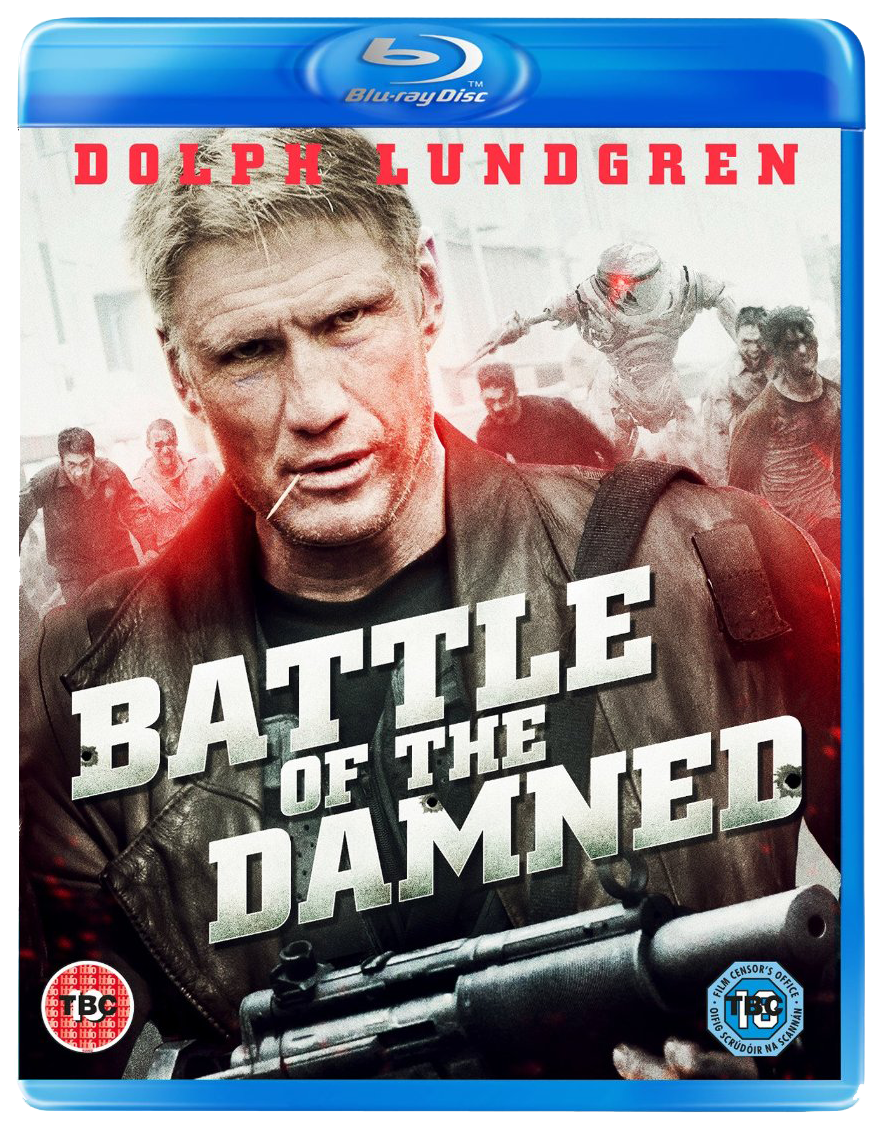
Battle of the Damned (Christopher Hatton, 2013)
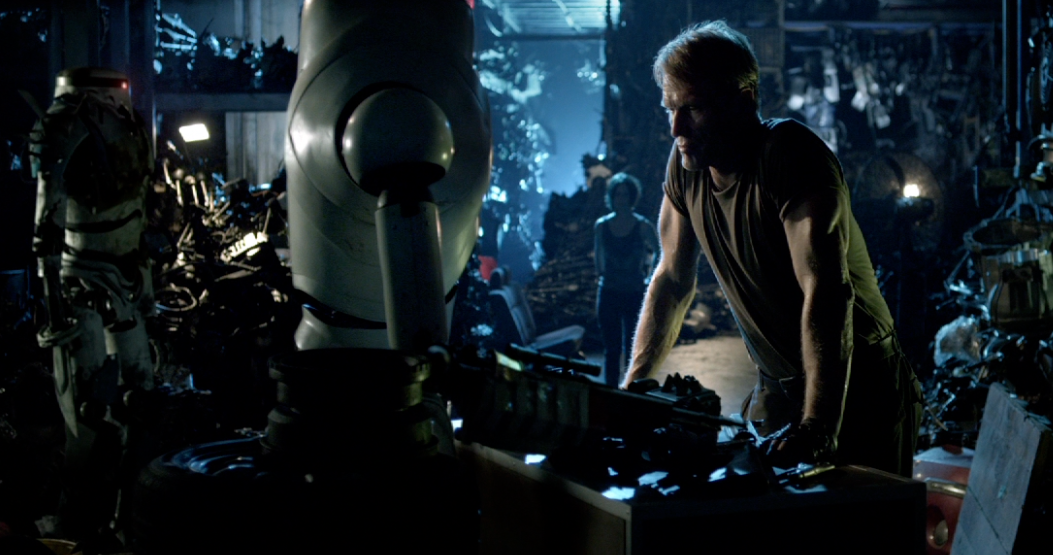 Dolph Lundgren has had an interesting career. The six foot four Swedish martial artist, with a Master’s degree in chemical engineering, became an action film star during the 1980s following his tenure as Grace Jones’ bodyguard and, later, her lover. After a brief appearance in the Bond picture A View to a Kill (John Glen, 1985), Lundgren was cast as Ivan Drago, the symbol of Soviet ideology who is pitted against the blue-collar US fighter Rocky Balboa (Sylvester Stallone), in Rocky IV (Stallone, 1985). From there, Lundgren developed a career as a star of action films, his roles encompassing comic book adaptations (Mark Goldblatt’s The Punisher, 1989), fantasy films (Masters of the Universe; Gary Goddard, 1987), and a wide variety of more typical action pictures of the era (Manny Coto’s Cover Up, 1991; Mark L Lester’s Showdown in Little Tokyo, 1991). His imposing physique and accent often led to him being cast as villains or anti-heroes who are defined by their slightly ‘alien’ characteristics (Lundgren was cast as a representative of Soviet ideology in both Rocky IV and Joseph Zito’s Red Scorpion, 1989). Dolph Lundgren has had an interesting career. The six foot four Swedish martial artist, with a Master’s degree in chemical engineering, became an action film star during the 1980s following his tenure as Grace Jones’ bodyguard and, later, her lover. After a brief appearance in the Bond picture A View to a Kill (John Glen, 1985), Lundgren was cast as Ivan Drago, the symbol of Soviet ideology who is pitted against the blue-collar US fighter Rocky Balboa (Sylvester Stallone), in Rocky IV (Stallone, 1985). From there, Lundgren developed a career as a star of action films, his roles encompassing comic book adaptations (Mark Goldblatt’s The Punisher, 1989), fantasy films (Masters of the Universe; Gary Goddard, 1987), and a wide variety of more typical action pictures of the era (Manny Coto’s Cover Up, 1991; Mark L Lester’s Showdown in Little Tokyo, 1991). His imposing physique and accent often led to him being cast as villains or anti-heroes who are defined by their slightly ‘alien’ characteristics (Lundgren was cast as a representative of Soviet ideology in both Rocky IV and Joseph Zito’s Red Scorpion, 1989).
During the late 1990s and early 2000s, Lundgren made a large number of films, most of them still predicated largely on action, but many of these were independent productions that struggled to find wide distribution. However, in the mid-2000s Lundgren’s career experienced something of a renaissance thanks to the new era of glossy direct-to-video productions, many of them shot cheaply in Eastern Europe, that flourished following the widespread adoption of digital home video formats. Lundgren made his directorial debut during this era, completing The Defender (2004) after the original director, Sidney J Furie, fell ill during pre-production. Following The Defender, Lundgren directed several self-starring films, each of them showing an increasing confidence in his handling of the tropes of the action film genre whilst also demonstrating an increasing emphasis on ‘meaty’ violence. The Mechanik (2007) and Missionary Man (2008) are particular highlights of this period of Lundgren’s career. Lundgren also returned to the template set by Roland Emmerich’s 1992 film Universal Soldier, in which Lundgren starred opposite Jean-Claude Van Damme as a genetically engineered supersoldier, in two films directed by John Hyams, the son of Peter Hyams: Universal Soldier: Regeneration (2010) and Universal Soldier: Day of Reckoning (2012). In addition to this, Lundgren’s status as an icon of 1980s action films was confirmed by his casting in Sylvester Stallone’s ‘throwback’ action picture The Expendables (2010). The success of The Expendables has been followed by Lundgren taking on a large number of roles in direct-to-video action pictures: in 2013 alone, he has starred in five DTV action films.
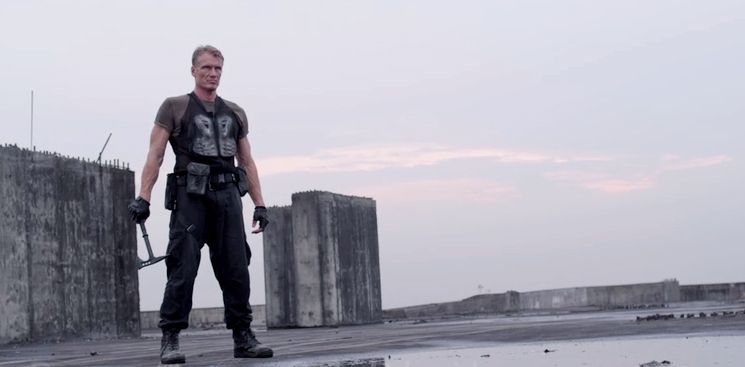 This film, Christopher Hatton’s Battle of the Damned (2013), features Lungren as Major Max Gatling. The film, shot in Malaysia, opens with a long string of title cards which reveal that in the near future, ‘Southeast Asia has become a haven for Biotechnology companies seeking to avoid regulation’. Within this climate, a ‘highly contagious pathogen’ has escaped from ‘a research facility’, infecting ‘an urban populace’: ‘The infection spreads rapidly, turning people into rabid carriers’, and as a result the city (nameless in the film but which, from the architecture and buildings, seems to be Nusajaya) is placed under quarantine and surrounded by a military blockade. ‘No one is allowed to enter or leave’, we are told, ‘Including the unafflicted’. Gatling, a mercenary, is pressed into action by a high-ranking employee of the biotech company responsible for the virus, who quietly hires Gatling (a veteran of the Battle of Mogadishu) and his crew to enter the city and rescue the businessman’s daughter. However, the incursion doesn’t go as planned, and many of Gatling’s platoon are killed; a handful of his men escape, but Gatling stays behind, alone, to continue his mission. After two weeks in the quarantine zone, Gatling encounters his target, Jude (Melanie Zanetti), who has joined a group of survivors led by Duke (David Field). Jude is pregnant to another member of the group, Reese (Matt Doran), and although she conceals this fact from both Reese and the other members of the group, it informs her decision not to escape with Gatling – who is under orders to only rescue Jude, before the city is firebombed in order to contain the virus. This film, Christopher Hatton’s Battle of the Damned (2013), features Lungren as Major Max Gatling. The film, shot in Malaysia, opens with a long string of title cards which reveal that in the near future, ‘Southeast Asia has become a haven for Biotechnology companies seeking to avoid regulation’. Within this climate, a ‘highly contagious pathogen’ has escaped from ‘a research facility’, infecting ‘an urban populace’: ‘The infection spreads rapidly, turning people into rabid carriers’, and as a result the city (nameless in the film but which, from the architecture and buildings, seems to be Nusajaya) is placed under quarantine and surrounded by a military blockade. ‘No one is allowed to enter or leave’, we are told, ‘Including the unafflicted’. Gatling, a mercenary, is pressed into action by a high-ranking employee of the biotech company responsible for the virus, who quietly hires Gatling (a veteran of the Battle of Mogadishu) and his crew to enter the city and rescue the businessman’s daughter. However, the incursion doesn’t go as planned, and many of Gatling’s platoon are killed; a handful of his men escape, but Gatling stays behind, alone, to continue his mission. After two weeks in the quarantine zone, Gatling encounters his target, Jude (Melanie Zanetti), who has joined a group of survivors led by Duke (David Field). Jude is pregnant to another member of the group, Reese (Matt Doran), and although she conceals this fact from both Reese and the other members of the group, it informs her decision not to escape with Gatling – who is under orders to only rescue Jude, before the city is firebombed in order to contain the virus.
The uber-macho name of Lundgren’s character in Battle of the Damned may provide a suggestion as to the direction in which this film takes the action picture, and the ambiguity that surrounds the film’s emulation of the tropes of action films. It’s a little unclear whether Hatton is intentionally parodying action film clichés or if his film is simply a blank pastiche of these tropes. The dialogue, some of which could have been written by applying William S Burroughs’ ‘cut up’ method to the scripts of numerous action pictures, is often risible – but seemingly intentionally so. (Gatling responds to a distressed colleague’s cry of ‘We need backup’ with the stock phrase ‘There is no backup’; in the same radio call, he is told that one of his platoon members turned into a zombie and ‘He fucking ate them’; elsewhere, another member of Lundgren’s platoon insightfully announces that ‘This whole fucking thing was fucked’.) Certainly, Lundgren brings a moderate sense of ironic detachment to his role here – but that is a characteristic of many of Lundgren’s performances in similar films.
Lundgren’s blank, detached, alienated and deadpan screen persona is his stock-in-trade and has attracted some interesting fans. Jim Jarmusch once noted in an interview that he ‘go[es] through periods’ where he has to watch every film made by a particular star: ‘I go off on binges. Could be Brigitte Bardot, could be Dolph Lundgren’ (Jarmusch, quoted in : 152). In the same interview, Jarmusch noted that amongst Lundgren, Jean-Claude Van Damme and Steven Seagal, Lundgren was his favourite: ‘I like how Dolph Lundgren is so robotic. He doesn’t pretend to have to play a character that has some emotional drama’ (Jarmusch, quoted in ibid.).
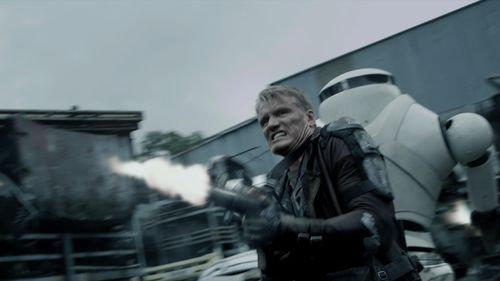 Speaking of which, alongside the ‘robotic’ Lundgren Battle of the Damned features a group of stray, deadly robots who are initially taken as being a danger to the human survivors but which are revealed to be ‘friendly’, aiding them in their flight from the city. These robots are in fact survivors of Hatton’s previous DTV action film Robotropolis (2011), in which they ran amok in a research facility. The events of that film are referenced by one of the robots here, who asserts that following the rampage, caused by a programming ‘blip’, the robots returned to their previous human-friendly programming. Hatton’s attempt to connect the narrative events of Battle of the Damned with those of Robotropolis is interesting but, given how dreadful Robotropolis was, hardly inspired. Nevertheless the robots, thrown into a mix which also includes Lundgren’s deadpan screen persona and rampaging zombies, add another element of adolescent playfulness to the film which is reflected in the dialogue. (At one point, Lundgren comments, ‘Zombies. Killer robots. Nice town you got here’.) Speaking of which, alongside the ‘robotic’ Lundgren Battle of the Damned features a group of stray, deadly robots who are initially taken as being a danger to the human survivors but which are revealed to be ‘friendly’, aiding them in their flight from the city. These robots are in fact survivors of Hatton’s previous DTV action film Robotropolis (2011), in which they ran amok in a research facility. The events of that film are referenced by one of the robots here, who asserts that following the rampage, caused by a programming ‘blip’, the robots returned to their previous human-friendly programming. Hatton’s attempt to connect the narrative events of Battle of the Damned with those of Robotropolis is interesting but, given how dreadful Robotropolis was, hardly inspired. Nevertheless the robots, thrown into a mix which also includes Lundgren’s deadpan screen persona and rampaging zombies, add another element of adolescent playfulness to the film which is reflected in the dialogue. (At one point, Lundgren comments, ‘Zombies. Killer robots. Nice town you got here’.)
Elsewhere, Reese, an employee of the biotech company which created the virus, is fond of pointing out to the other characters that the ‘zombies’ (which run rather than shamble) are in fact humans who have been infected with a virus. It’s a nerdish distinction which highlights the fact that this film has more in common with films about rampaging urban flesh-eaters, such as Umberto Lenzi’s Nightmare City/Incubo Sulla Cittá Contaminata, 1980) and Danny Boyle’s 28 Days Later (2002), than with either traditional zombie films (Jacques Tourneur’s I Walked with a Zombie, 1943) or even later George Romero-influenced pictures about flesh-eating ghouls (for example, Lucio Fulci’s Zombi 2/Zombie/Zombie Flesh Eaters, 1979, or the recent popular television series The Walking Dead, AMC, 2010- ). Reese’s assertion, when he and Gatling first encounter the robots and realise they are friendly, that he is having a ‘nerdgasm’ speaks volumes about the tone of the film and its ‘everything but the kitchen sink’ approach.
The film’s violence is particularly brutal; one area in which this film clearly improves on Hatton’s Robotropolis is in the director’s handling of action. The film opens on action as, following the aforementioned titles which explain the outbreak that has caused the mayhem, Hatton uses parallel editing to alternate between Gatling being given his orders by the employee of the unnamed biotech company, and Gatling and his team being chased through the city streets by zombies. Hatton quickly establishes a hostile urban environment that, thanks to the Malaysian architecture, is exotic and thus slightly reminiscent of Lucio Fulci/Bruno Mattei’s Zombi 3 (1988) and Claudio Fragasso’s Oltre la morte/After Death, both of which were shot in the Philippines. There’s an emphasis on martial arts which is to be expected from a Lundgren film: Gatling and his team used martial arts during the opening sequence, and one of the member’s of Duke’s band of survivors, Elvis (Jen Kuo Sung) waxes philosophical on the katana he uses to eliminate the zombies (‘They say swordsman that never draws his sword is a true master; “they” don’t know shit about zombies’).
Video
Shot on HD digital video (using the Red EPIC), Battle of the Damned is presented here in 1080p, using the AVC/MPEG-4 codec, and with an aspect ratio of 1.78:1. The Red EPIC reputedly has a dynamic range (13.5 stops) that is very similar to that of 35mm film, although as with much shot-on-digital material it lacks the ‘organic’ structure of a movie shot on 35mm (the regular grid of pixels in a digital image has a very different feel to the irregular patterns of grain within film emulsions). Much of the film has a slightly overexposed, bleached-out look that seems to be used as a signifier of the future. (It’s perhaps worth comparing this with Dario Argento’s use of a bleached white aesthetic to signify that Tenebre takes place in the future; see our recent review of Arrow Video’s remastered rerelease of that particular title.) Bearing this in mind, the presentation on this disc is clean and clear, with plenty of detail; but it has the inorganic look of much material shot on HD digital video.

Audio
There are two audio options on the disc: a DTS-HD Master Audio 5.1 track, which is immersive and makes strong use of surround effects but which features dialogue that is often ‘buried’ in the sound mix, and a Linear PCM 2.0 stereo track which is more satisfying in terms of the audibility of dialogue but obviously doesn’t feature the same rich surround sound experience. Optional English subtitles for the Hard of Hearing are included.
Extras
The disc’s only extras are bonus trailers, which play on startup and are skippable, for Riddick (1:47), The Colony (2:14), Metallica Through the Never (1:52) and the remake of We Are What We Are (2:29). (All of these are in HD.)
Overall
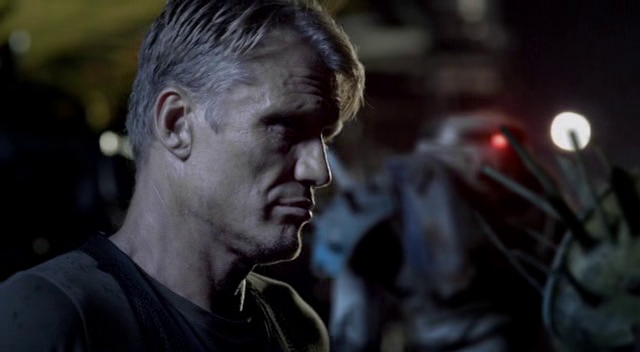 Battle of the Damned offers a hodgepodge of elements from other films. Aside from obvious reference points (the biotech company that creates the virus and then somehow organises the firebombing of the city as a ‘cover up’ has obvious parallels with the Umbrella Corporation in the Resident Evil video games, books and films), Gatling’s mission to enter the quarantine zone and rescue the daughter of the businessman who hires him, recalls Snake Plissken’s (Kurt Russell) mission to rescue the president (Donald Pleasence), after Airforce One crashes behind the wall of Manhattan maximum security penitentiary, in John Carpenter’s Escape From New York (1981). Likewise, both films feature similar sequences in which their surly, insolent protagonists are, somewhat reluctantly, hired by corporate officers who praise Gatling’s/Plissken’s respective military experience. Where the unnamed businessman who hires Gatling singles out Gatling’s experiences in Mogadishu as an index of his ability to complete the mission (‘You can get through that blockade, and no one will ever know’), in Escape from New York Bob Hauk (Lee Van Cleef) references Plissken’s military experience whilst enlisting him (reluctantly) to rescue the president (‘You flew the Gullfire over Leningrad. You know how to get in quiet. You're all I got’). The dynamic that evolves between Gatling, who proposes escape from the city, and Duke, who asserts that ‘All we can do is survive, outwit the virus’ and refuses to leave the survivors’ ‘safehouse’ (the luxurious Sultan Ismail building in Kota Iskandar), seems to openly reference the conflict between Ben (Duane Jones) and Harry (Karl Hardman) in George A Romero’s Night of the Living Dead (1968) – in which Ben asserts that the group must remain on the ground floor of the farmhouse in which they find themselves besieged by zombies, so as to allow them to flee, whilst Harry believes the group will be safer if they entrench in the basement. Elsewhere, Hatton also manages to build in to the film fleeting visual references to films such as Lamberto Bava’s Demoni/Demons (1985): towards the end of the film, as Gatling, Jude and Reese shelter in a huge underground structure, Hatton shows the zombies, framed in the centre of the image, running down a ramp in silhouette – an image which seems to directly allude to a very similar shot in Demons that was used on various posters and videocassette covers for the film. Battle of the Damned offers a hodgepodge of elements from other films. Aside from obvious reference points (the biotech company that creates the virus and then somehow organises the firebombing of the city as a ‘cover up’ has obvious parallels with the Umbrella Corporation in the Resident Evil video games, books and films), Gatling’s mission to enter the quarantine zone and rescue the daughter of the businessman who hires him, recalls Snake Plissken’s (Kurt Russell) mission to rescue the president (Donald Pleasence), after Airforce One crashes behind the wall of Manhattan maximum security penitentiary, in John Carpenter’s Escape From New York (1981). Likewise, both films feature similar sequences in which their surly, insolent protagonists are, somewhat reluctantly, hired by corporate officers who praise Gatling’s/Plissken’s respective military experience. Where the unnamed businessman who hires Gatling singles out Gatling’s experiences in Mogadishu as an index of his ability to complete the mission (‘You can get through that blockade, and no one will ever know’), in Escape from New York Bob Hauk (Lee Van Cleef) references Plissken’s military experience whilst enlisting him (reluctantly) to rescue the president (‘You flew the Gullfire over Leningrad. You know how to get in quiet. You're all I got’). The dynamic that evolves between Gatling, who proposes escape from the city, and Duke, who asserts that ‘All we can do is survive, outwit the virus’ and refuses to leave the survivors’ ‘safehouse’ (the luxurious Sultan Ismail building in Kota Iskandar), seems to openly reference the conflict between Ben (Duane Jones) and Harry (Karl Hardman) in George A Romero’s Night of the Living Dead (1968) – in which Ben asserts that the group must remain on the ground floor of the farmhouse in which they find themselves besieged by zombies, so as to allow them to flee, whilst Harry believes the group will be safer if they entrench in the basement. Elsewhere, Hatton also manages to build in to the film fleeting visual references to films such as Lamberto Bava’s Demoni/Demons (1985): towards the end of the film, as Gatling, Jude and Reese shelter in a huge underground structure, Hatton shows the zombies, framed in the centre of the image, running down a ramp in silhouette – an image which seems to directly allude to a very similar shot in Demons that was used on various posters and videocassette covers for the film.
The film begins strongly, with some effective action setpieces, but when Gatling teams up with Duke’s band of survivors (after the opening credits, which take place no less than fifteen minutes into the film) the pace slows to a crawl, only to pick up once again when the robots are introduced. Ultimately, it’s an interesting but derivative film, punctuated by some good one-liners (‘Jude, you have a friend… A very large friend’, Duke comments upon meeting Gatling for the first time) and given an additional element of interest via its exotic locations. Hatton manages to convey a strong sense of urban desolation, and the film is a definite step above Robotropolis; however, it’s also a definite step below the films Lundgren has directed himself (for example, Missionary Man). Nevertheless, there’s much to be said in favour of a film that combines such diverse genre elements with the confidence that Hatton displays here.
References:
Macauley, Scott, 1996: ‘End of the Road’. In: Hertzberg, Ludvig (ed), 2001: Jim Jarmusch: Interviews. University Press of Mississippi: 148-53
This review has been kindly sponsored by E-One Entertainment.
| The Film: |
Video: |
Audio: |
Extras: |
Overall: |
|

